Vancouver, Victoria and Seattle 7 day Itinerary
Last Updated on December 10, 2024
If you’re looking for an urban seven day trip to see the best cities of the Pacific Northwest, with beautiful ferry rides through islands in view of towering mountains, then a Vancouver, Victoria and Seattle week long trip is for you!
You’ll get to experience the best of the urban Pacific Northwest as well as take in the stunning natural beauty in our part of the world. I’m a born and raised Seattleite and I grew up with family in Victoria. I’ve been to these places many times, love them dearly and can’t wait to share it with you.
This is an ideal car free trip though you can also do it in a car. If you’re driving, be ready for lots of traffic, parking hassles and get ferry reservations. If you like to travel car free, then this itinerary is perfect for you. I’ll tell you how to make it work both with and without a car.
You’ll be crossing the border between Canada and the United States, so make sure to have your passport.
- Vancouver, Victoria and Seattle without a car
- Vancouver, Victoria and Seattle driving itinerary
- Where to stay in each city
- Tips for getting around each city
- Day 1 – Vancouver
- Day 2 – Vancouver
- Day 3 – Vancouver to Victoria
- Day 4 – Victoria
- Day 5 – Victoria to Seattle
- Day 6 – Seattle
- Day 7 – Seattle
- What’s the weather like in Vancouver, Victoria and Seattle?
- What to pack for a week in Vancouver, Victoria and Seattle
Vancouver, Victoria and Seattle Itinerary without a car
This is an ideal itinerary without a car. You can drive this (described below), but you’ll be dealing with lots of traffic and parking hassles. If you’re up for a car free adventure, a week in Vancouver, Victoria and Seattlle is a great place to start. If you prefer traveling without a car, then this itinerary is absolutely ideal for you!
I’m describing this trip starting in Vancouver and ending in Seattle, but you can also do it the other way. To make it a loop starting and ending in Seattle or Vancouver, take Amtrak Cascades between the two cities on Day 1 (or Day 7).
You can take the city bus from Vancouver to the Tsawwassen ferry terminal, then the ferry to Swartz Bay and then the city bus again from Swartz Bay to downtown Victoria. I’ve done this plenty of times and Google Maps works great to navigate the transit transfers and timing Another option to get from Vancouver to Victoria is to take the BC Connector, which costs more but there’s less for you to figure out. Check the BC Connector schedule and fares from Vancouver to Victoria here.
In Victoria, you can walk or take the bus around town and out to Butchart Gardens. The Victoria Clipper ferry which is a foot ferry that whisks you from Victoria to downtown Seattle goes right from the Inner Harbor.
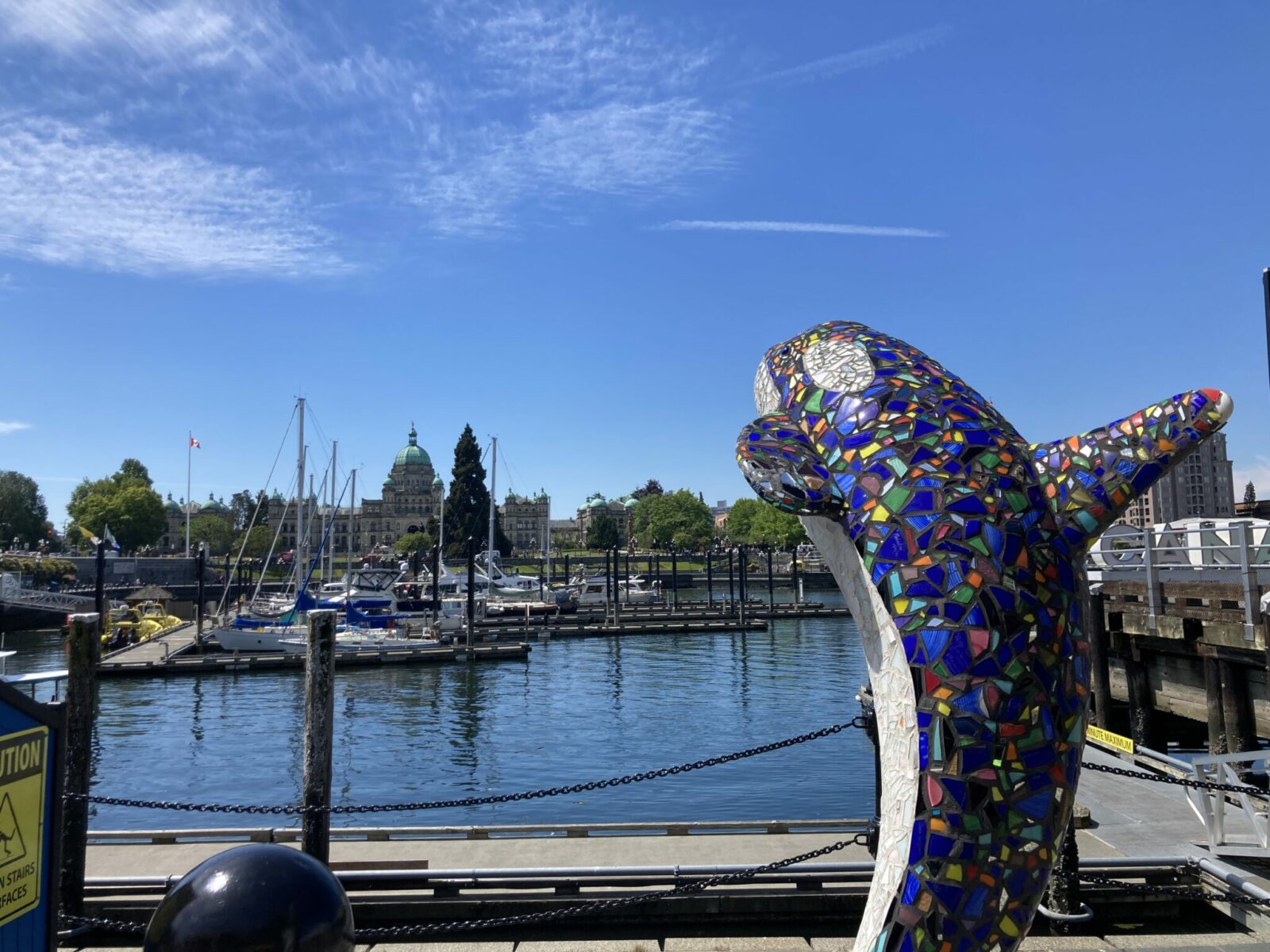
Vancouver, Victoria and Seattle Driving itinerary
If you’re driving for your Vancouver, Victoria and Seattle trip, give yourself plenty of extra time for traffic, border crossings and ferry waits. Expect to pay a lot for parking, I suggest parking once and getting around by transit (except for Butchart Gardens, if you have a car it makes sense to drive there).
If you’re driving, you’re likely going to start and end in either Seattle or Vancouver and you can drive between them at the beginning or the end on Day 1 or 7.
You’ll be driving between Vancouver and the Tsawwassen ferry terminal and from the Swartz Bay ferry terminal to Victoria. Make sure to have a reservation for your vehicle for the ferry.
When you leave Victoria to head to Seattle, you can either take the ferry back to Vancouver and go to Seattle that way, or you can take the Coho ferry from Victoria’s Inner Harbour to Port Angeles and then drive to the Bainbridge Island ferry to take the ferry to downtown Seattle. Reservations for a vehicle on the Coho ferry are necessary.
Those without cars can take the Victoria Clipper from Victoria to Seattle in less than three hours, but taking a car on the other ferries and the additional drive will take most of the day so build in extra time for that.
Where to stay
I strongly recommend booking a hotel in the downtown area in Vancouver, Victoria and Seattle if you are doing your trip without a car. It will make your life so much easier to be close to transit and make it easier and faster to get around.
If you’re driving, you might tempted to stay elsewhere but keep in mind that traffic in all three of these cities is pretty intense and you’ll probably be happier parking your car at a downtown hotel and walking or taking transit for sightseeing.
Tips for Getting around

I am a Seattleite and I go to Vancouver and Victoria frequently. I leave my car at home if I’m planning to be spending time in the city. Vancouver, Victoria and Seattle all have terrible traffic and expensive and complicated parking. It’s just so much easier to get around on transit.
Vancouver has the best public transit of any of these three cities. Between the Skytrain, Seabus, the bus and the little foot ferries crossing the waterways through the city, it’s really easy to get around. Taking the bus to the ferry terminal on both sides is easy.
Victoria has a good bus system, though as a visitor you can pretty much walk everywhere, the Inner Harbour is extremely walkable. You can take the city bus out to Butchart Gardens, or you can book a tour with a direct transfer there which costs a bit more but it’s faster. The city bus takes about an hour to get there and on a tour bus it will be more like 30-45 minutes.
Seattle’s transit system can be a little confusing, and the shape of the city can make it a bit slow. Getting around downtown on foot is very doable, though there are some steep hills. The monorail takes you from downtown to Seattle Center where you’ll find the Space Needle and Chilhuly Gardens and Glass. The bus and light rail can get you between downtown and the airport or the University, and with a little more time taking the bus to the Ballard area works well. You can walk to the Pioneer Square neighborhood, the International District and the stadiums, or take a short bus ride from downtown.
Day 1 – Vancouver
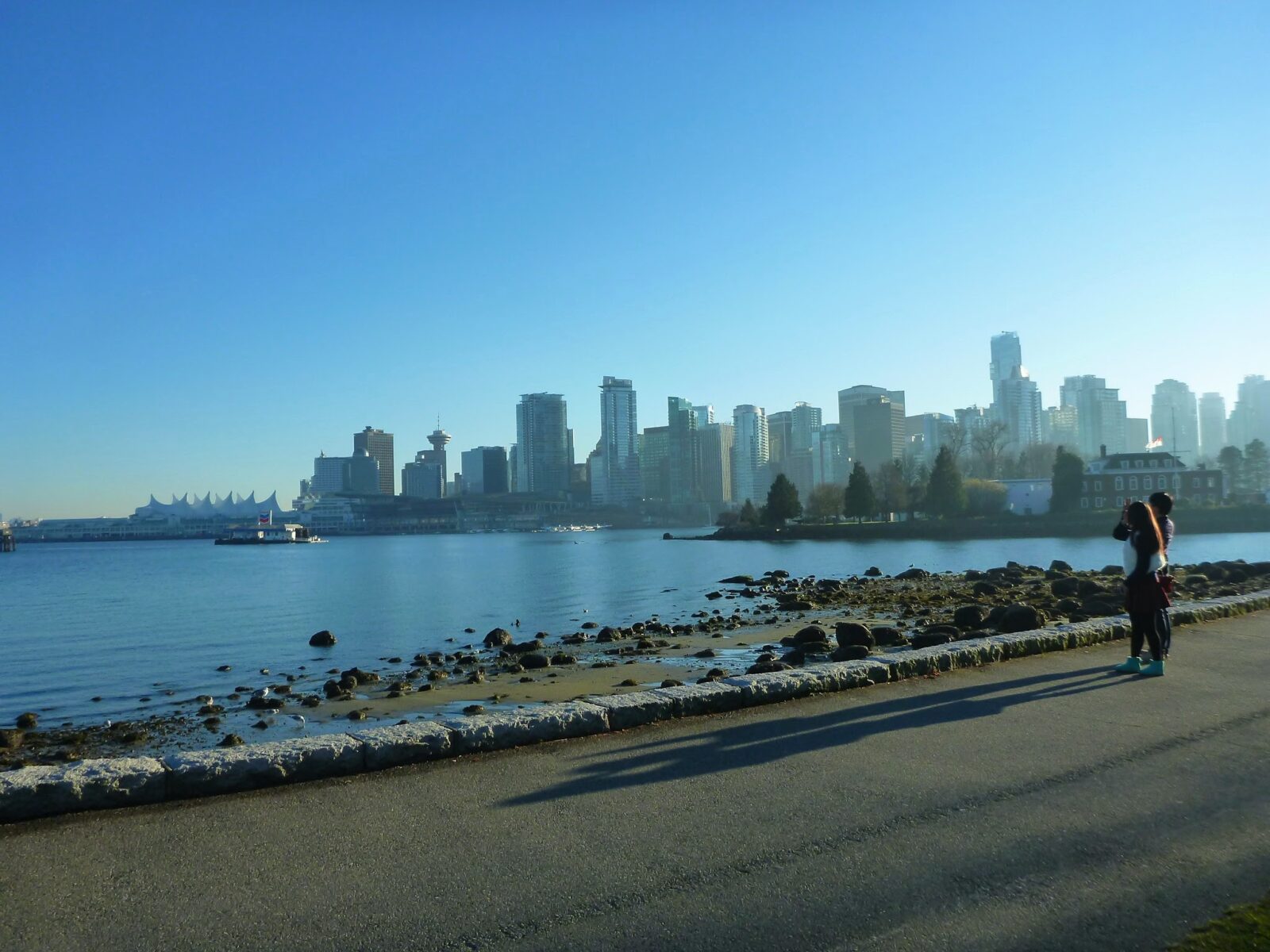
Grab coffee and a donut for breakfast like Vancouverites do and head to Stanley Park. There’s no question that if you’re going to one thing in Vancouver, make it Stanley Park. Walk along the Seawall, explore the old growth forest in the middle of the park and check out the impressive totem poles. You can rent a bike for even more exploring.
While you’re in Stanley Park, check out the Vancouver Aquarium and learn all about the animals of the Salish Sea. Alternatively, head over to Canada Place for FlyOver Canada for epic views no matter what the weather is doing.
Head to Japadog (food carts all over town) for a Japanese hot dog with lots of delicious Japanese toppings in endless combinations.
Granville Island is another absolute must do in Vancouver. Granville Island is full of shops, restaurants, produce stands and art. Wander around and find food for lunch as you explore this gem in Vancouver. For extra fun, ride the foot ferry around false creek and to and from Granville Island.
Check out the remnants from the 2010 Olympics at the nearby Olympic Village and have dinner in Yaletown before heading over to English Beach to watch the sunset (or do the sunset before dinner depending on the time of year).
Day 2 – Vancouver
I recommend deciding to spend your second day in Vancouver exploring its rich cultural history or it’s impressive outdoors.
For a cultural day, walk or take the bus or sky train to Chinatown for Dim Sum. Dim Sum is a traditional Chinese meal that is very popular on in Vancouver. It is typically eaten at brunch time, late morning and midday. It involves lots of dumplings and other shareable plates and lots of tea.
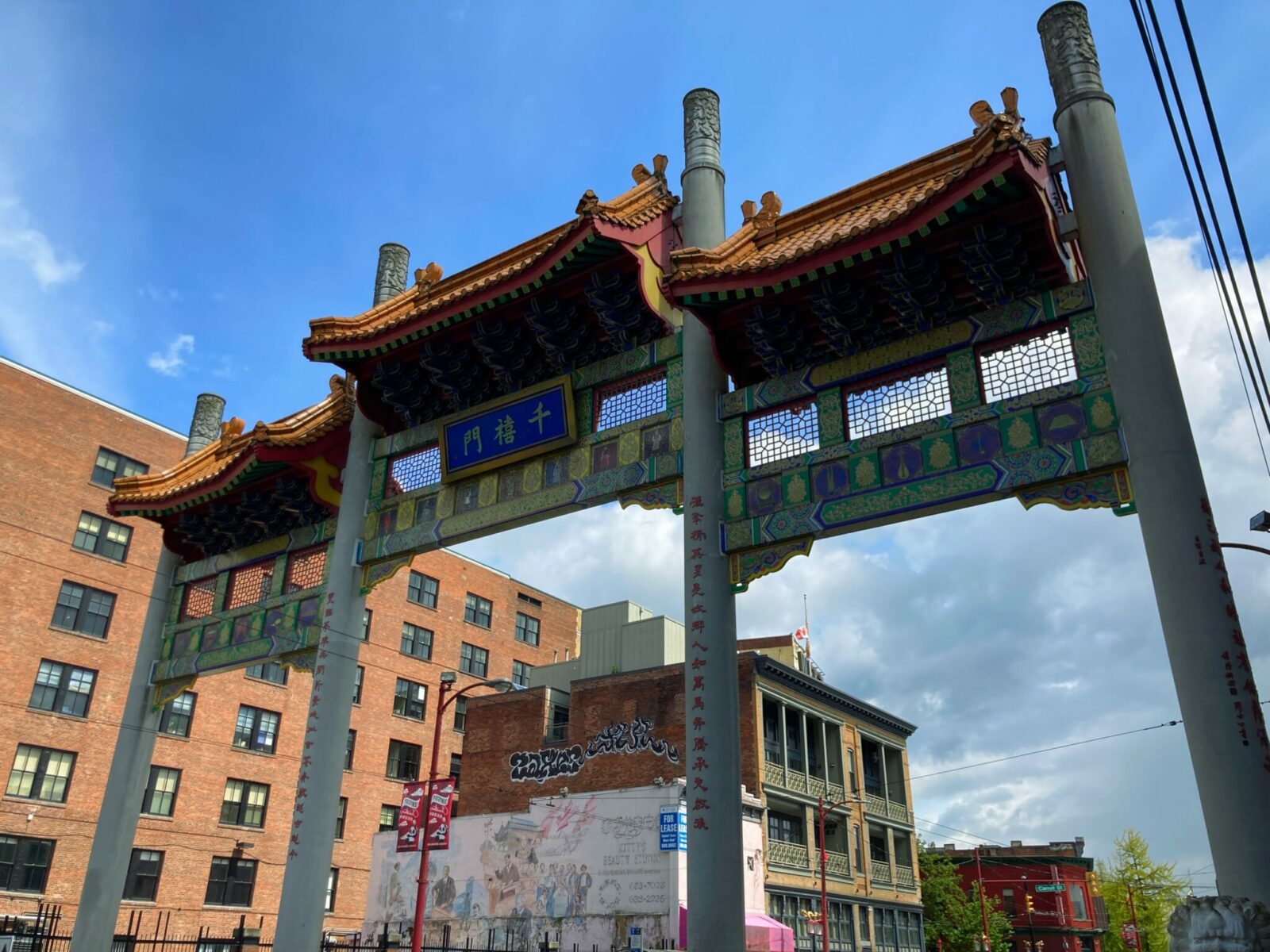
After that, head to the University of British Columbia campus and visit the UBC Museum of Anthropology. There are also several forest trails nearby if you want to get more walking or hiking in. After that, continue your exploration of Indigenous Northwest Coast art and culture with a visit to the Bill Reid Gallery.
If you’d prefer to explore some of Vancouver’s natural wonders, take the Seabus to North Vancouver and then the bus to Grouse Mountain. The gondola ride to the top of the mountain brings epic views of Vancouver, Howe Sound and the Coast Mountains. I would say it’s only worth it if it’s good enough weather to see the view. This is a popular ski area in winter, but you can still ride the gondola even if you’re not skiing.

Another option is to head to popular Capilano Bridge Suspension Park, which is near Grouse Mountain (get there by Seabus to North Vancouver then city bus). They also offer a free shuttle from Canada Place in downtown Vancouver. At Capilano, you can walk high bridges and walkways suspended in the middle of the rainforest canopy and across the canyon.
However you spend the day, enjoy dinner at one of the delicious gastropubs in the Gastown neighborhood, and make sure to stop by the historic steam clock at the top of the hour.
Day 3 – Vancouver to Victoria

A good portion of today will be spent taking the beautiful trip from downtown Vancouver to Victoria’s Inner Harbour by way of a ferry ride through the unforgettable Gulf Islands. Depending on exactly how you travel will determine the amount of time the trip takes, but it’s likely to take 4-6 hours.
Have a leisurely morning with breakfast at your hotel, or take a walk on one of Vancouver’s amazing trails before catching your bus to the ferry. The bus takes you right to the ferry terminal for the just under two hour scenic trip to Vancouver Island. When you dock in Swartz Bay, you’ll board the bus again to get into downtown Victoria, which takes about an hour in typical traffic.
After you check into your hotel, take a walk around the Inner Harbour and have dinner in view of all the boat and float plane activity.
Day 4 – Victoria
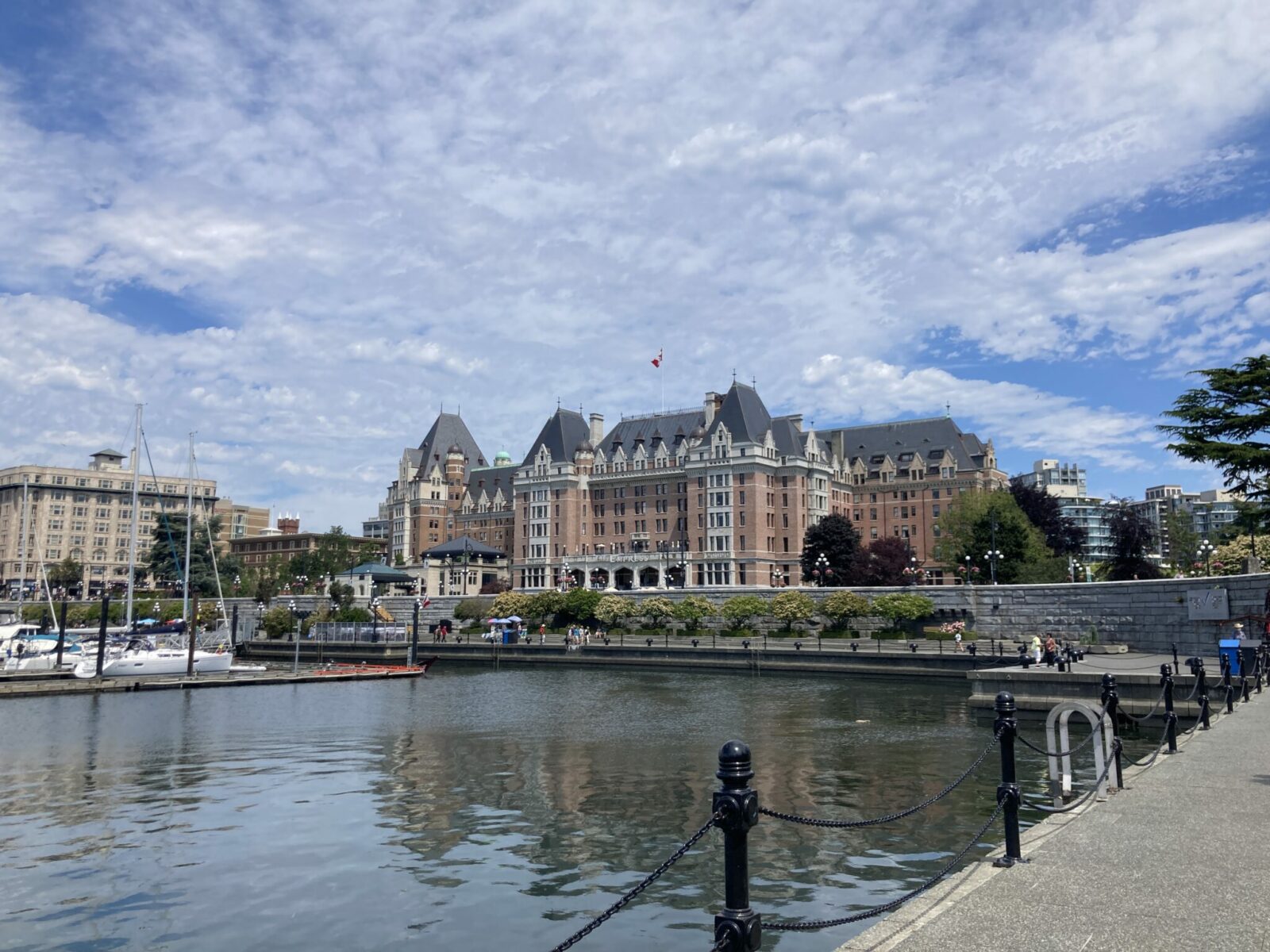
Even though it’s very busy with visitors, Butchart Gardens is a must do in Victoria for most visitors. It’s a truly stunning garden most of the year. Spring brings the colorful bulb flowers we are known for in the Pacific Northwest, summer has the peak bloom for even more flowers, fall has vibrant fall flowers and fall foliage in the Japanese Garden and the holidays have wonderful holiday decorations and lights. In my opinion, and I am very experienced with this, they also offer the best afternoon tea in Victoria. Enjoy that for lunch after you explore the gardens (get a reservation).

Victoria is an excellent whale watching destination, the best option of the cities you’re visiting on this itinerary. Orca whales are frequently seen in the waters surrounding Victoria and there are plenty of tours that go directly from the Inner Harbour.
Enjoy another evening with dinner in the Inner Harbour, or walk out to Dallas Road for fish and chips near the breakwater and an amazing sunset.
Day 5 – Victoria to Seattle
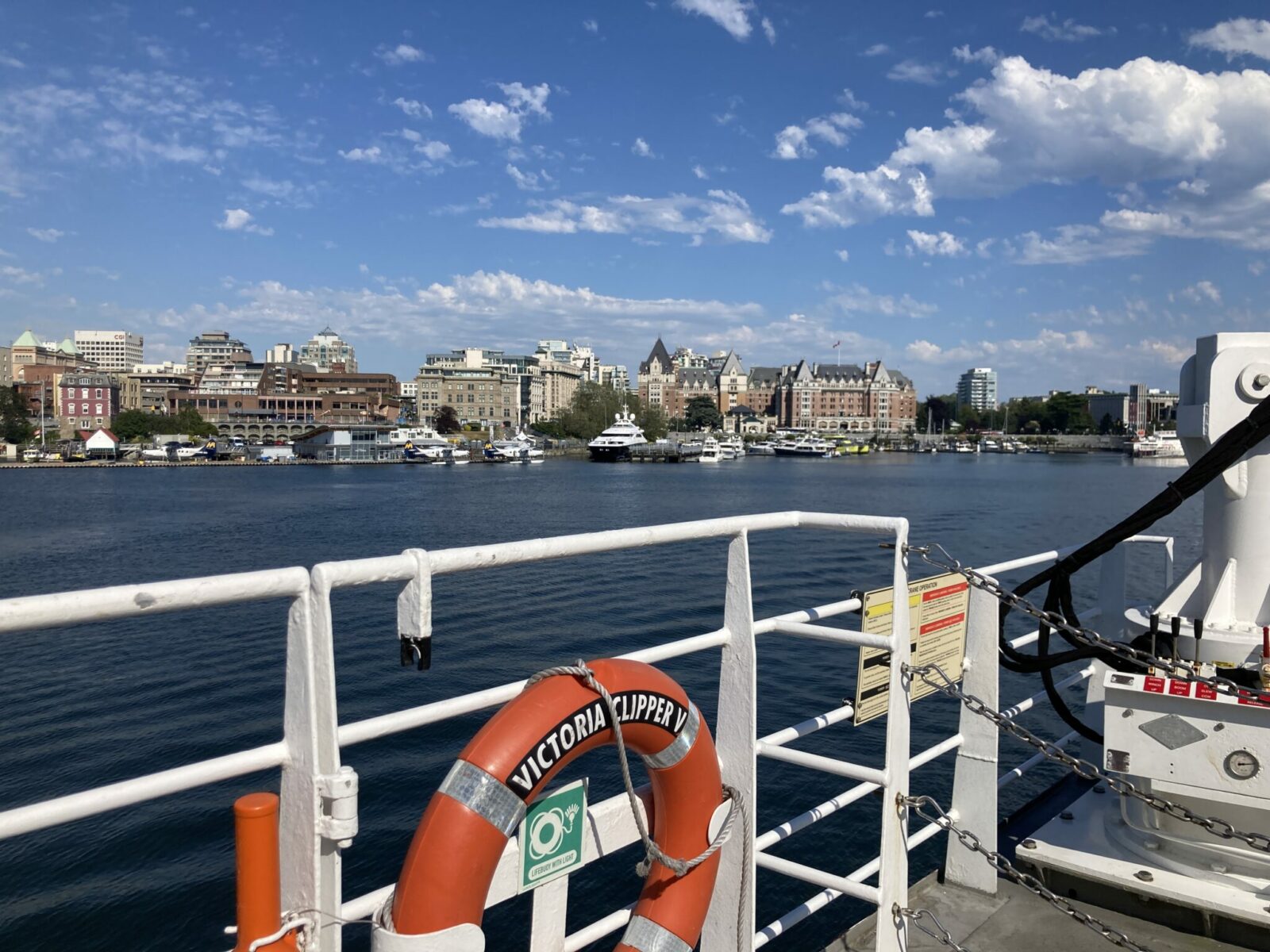
Note: I’m describing this day as if you were taking the Victoria Clipper passenger only ferry to Seattle in the evening, giving you most of the day in Victoria. If you’re driving, you’ll need to take the BC ferry back to Vancouver OR the Coho ferry to Port Angeles. If you’re driving, the trip will take most of the day and you need reservations. If you take the Victoria Clipper, the trip is just 3 hours.
Spend the morning exploring one of Victoria’s excellent museums, such as the Royal BC Museum or the Maritime Museum and then head to Government Street to check out some of the wonderful local shops. Make sure you don’t miss Roger’s Chocolates and Munro’s Books as well as Murchie’s Coffee and Tea.
The Empress Hotel is the most famous place for Afternoon Tea, but as I mentioned, I prefer the tea offering at Butchart Gardens (and it’s less expensive). However, if you want to have tea at the Empress, make sure to get a reservation. As an alternative you can take a stroll through the very impressive lobby and have lunch at Murchie’s instead which is what I do when I’m in Victoria.
If you have time before your Victoria Clipper ferry, take a walk or a Tally-ho carriage ride through Beacon Hill Park, an enormous and beautiful park behind the Parliament Buildings.
Day 6 – Seattle
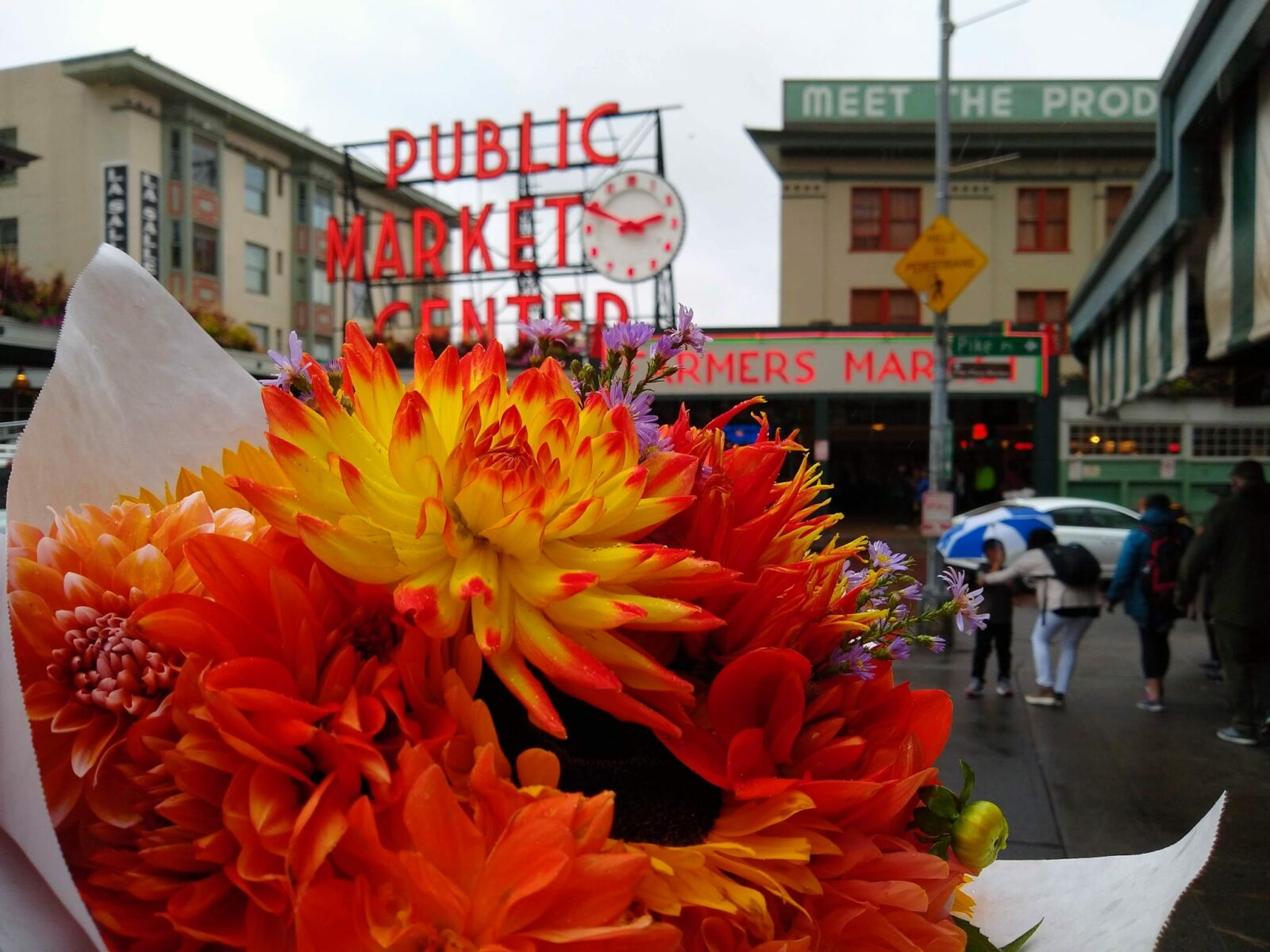
Start your day with a crumpet from the Crumpet Shop and spend a bit of time exploring Pike Place Market. Yes, Pike Place Market is touristy, and yes you still need to go. I live her and I go there frequently! There’s so much wonderful food and there are so many locals selling local products and food. Don’t miss out just because there are lots of other people enjoying it too.
I’d recommend having lunch there also and then making your way down to Pioneer Square. It’s about a mile to walk there from downtown, or you can take the bus. Once you arrive, take the elevator up the historic Smith Tower (my favorite view in Seattle) and enjoy a drink and a snack. While you’re in Pioneer Square, check out the Klondike Gold Rush National Park Museum and the Underground Tour or Beneath the Streets for a bit of Seattle history. I also recommend the Wing Luke Museum in the nearby International District (another great alternative for lunch).
For the evening, take the ferry across to Bainbridge Island for dinner and see some of the best views of downtown Seattle from the ferry ride and enjoy some tasting food and wine half an hour across the water and a world away on Bainbridge. Enjoy the sunset on the way over or back, depending on the time of year and what time you like to eat dinner.
Day 7 – Seattle
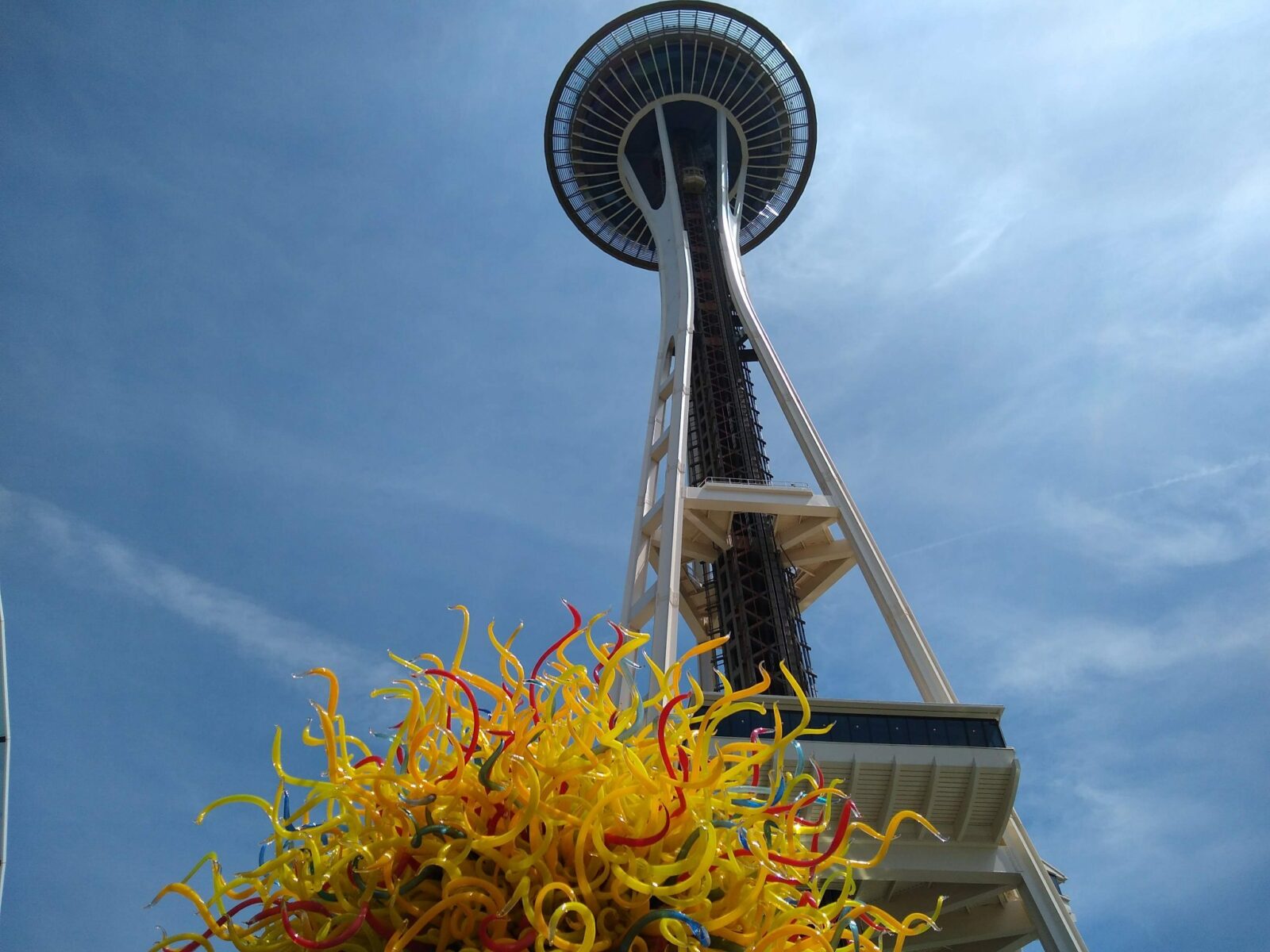
To explore more Seattle highlights, take the Monorail to Seattle Center. Head up to the Space Needle if you want to see another great view from an iconic building. There’s a relatively new glass floor that you can walk out on if you are into that kind of thing.
If you’re not sure about the Space Needle, let me assure you that checking it out from below and taking a photo is totally ok. You definitely do not want to miss Chihuly Gardens and Glass, a gorgeous glass art museum right below the Space Needle with great views of it.
If it’s summer, make sure to check out the International Fountain, which is set up for splashing and has music and lights.
In the afternoon, head to the Ballard neighborhood to explore the Ballard Locks and Golden Gardens Park which has one of the best beaches in Seattle. This is a good place for lunch or happy hour, with lots of local restaurants and many breweries.
If you have time and energy, head to the University of Washington and go for a walk around campus or visit the Burke Museum (make sure to get some fry bread from Off the Rez while you’re there). You can take the bus between Ballard and UW, or if you’re into long walks you can also walk there on the flat, paved Burke Gilman Trail, with beautiful views of the city and unique Gasworks Park. It’s about 5.5 miles walking.
Take a walk along Myrtle Edwards Park at sunset, or if you’re ready to sit down, enjoy dinner and a sunset along the waterfront.
Related: Best 3 day Seattle itinerary from a Seattleite
What’s the weather like in Vancouver, Victoria and Seattle?
Vancouver, Victoria and Seattle all have very similar climates. Summer (July through early September) is generally dry and warm (70s and 80s Fahrenheit) and occassionally hot. Despite this, rain is possible any time of year in the coastal Pacific Northwest. Summer also has long hours of daylight.
Winter (Mid November through mid February) is mild with lots of rainy days and lots of cloudy days that are fairly dry. There are intense wind and rain storms from time to time and occasional snow. Snow in winter in each of these cities definitely happens, but it’s a big event that happens once or twice a year, sometimes not at all. Temperatures are usually in the 40s Fahrenheit during the day, but can be warmer or colder. Winter days are short with the sun setting around 4pm.
In Spring and Fall, weather is much less predictable and different types of weather are possible even in the same day. Spring is generally late February through June, with lots of cloudy days, some sunny warm days and plenty of rain. Spring is still winter in the mountains with deep snow until late June. Temperatures can be anywhere between the 50s and the 80s so you’ll need to be ready for anything!
Fall (late September through mid November) has lots of sunny summer like days, and other days that feel more like winter. You’ll need to be ready for anything in Fall too.
What to pack for a week Vancouver, Victoria and Seattle
A few critical things to make sure to pack for your trip:
- Your Passport – This is an international trip and you’ll be crossing the border twice.
- Rain jacket and/or umbrella – you do not want to be without rain protection any time of year in the Pacific Northwest.
- Late September through June having waterproof footwear is a really good idea, or at least footwear that won’t be uncomfortable if you get wet.
- In summer, it can get quite hot and many buildings do not have air conditioning. Make sure to bring some very lightweight layers for hot days, especially if you’re staying in a vacation rental (hotels usually have air conditioning)
- All of these cities are very casual, while you can dress up if you want to, you’re not likely to encounter a situation where any kind of dressing up is required.
- I have lots of ideas about specific products if you’re looking to buy something new for your trip.









